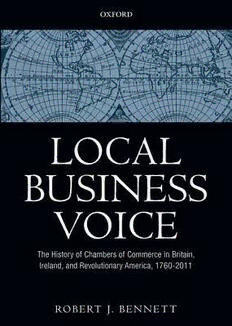
Local Business Voice: The History of Chambers of Commerce in Britain, Ireland, and Revolutionary America, 1760-2011 PDF
Preview Local Business Voice: The History of Chambers of Commerce in Britain, Ireland, and Revolutionary America, 1760-2011
LOCAL BUSINESS VOICE This page intentionally left blank Local Business Voice The History of Chambers of Commerce in Britain, Ireland, and Revolutionary America – 1760 2011 ROBERT J. BENNETT 1 3 GreatClarendonStreet,OxfordOX26DP OxfordUniversityPressisadepartmentoftheUniversityofOxford. ItfurtherstheUniversity'sobjectiveofexcellenceinresearch,scholarship, andeducationbypublishingworldwidein Oxford NewYork Auckland CapeTown DaresSalaam HongKong Karachi KualaLumpur Madrid Melbourne MexicoCity Nairobi NewDelhi Shanghai Taipei Toronto Withofficesin Argentina Austria Brazil Chile CzechRepublic France Greece Guatemala Hungary Italy Japan Poland Portugal Singapore SouthKorea Switzerland Thailand Turkey Ukraine Vietnam OxfordisaregisteredtrademarkofOxfordUniversityPress intheUKandincertainothercountries PublishedintheUnitedStates byOxfordUniversityPressInc.,NewYork #RobertJ.Bennett2011 Themoralrightsoftheauthorhavebeenasserted DatabaserightOxfordUniversityPress(maker) Firstpublished2011 Allrightsreserved.Nopartofthispublicationmaybereproduced, storedinaretrievalsystem,ortransmitted,inanyformorbyanymeans, withoutthepriorpermissioninwritingofOxfordUniversityPress, orasexpresslypermittedbylaw,orundertermsagreedwiththeappropriate reprographicsrightsorganization.Enquiriesconcerningreproduction outsidethescopeoftheaboveshouldbesenttotheRightsDepartment, OxfordUniversityPress,attheaddressabove Youmustnotcirculatethisbookinanyotherbindingorcover andyoumustimposethesameconditiononanyacquirer BritishLibraryCataloguinginPublicationData Dataavailable LibraryofCongressCataloginginPublicationData Dataavailable TypesetbySPIPublisherServices,Pondicherry,India PrintedinGreatBritain onacid-freepaperby MPGBooksGroup,BodminandKing’sLynn ISBN 978–0–19–958473–4 1 3 5 7 9 10 8 6 4 2 Preface This book seeks to provide the first systematic scholarly study of chambers of commerce and related organizations. It seeks to be definitive and exhaustive in order to provide to other researchers, and to the chamber system itself, a proper understanding of both local variations and broad trends and dynamics. The book alsoconstructsaresourceoflong-termalignedlocaldatathatcanbeusedforfuture benchmarking and long-term comparative research, which has been deposited at theUKDataArchive. Thepreparationofthebookhasdependedchieflyonawiderangeofsourcesheld in Local Record and Archive Offices, Libraries, Universities, and Local Studies Centres,andinlocalchambersthemselves.Nationalsourceshavealsobeenheavily used: chiefly the London Guildhall Library and London Metropolitan Archives, British Library, Newspaper Library (Colindale), The National Archives at Kew, PublicRecordOfficeNorthernIreland,IrishNationalArchives,NationalLibraryof Scotland,BritishLibrary,OxfordBodleianLibrary,LondonSchoolofEconomics, CambridgeUniversityLibrary,UniversityCollegeLondon,SocietyofGenealogists, SheffieldArchives(Wentworth-WoodhouseMuniments),USLibraryofCongress, and the two national organizations (the British Chambers of Commerce, and ChambersIreland).Inaddition,forincorporatedchambers,theCompaniesRegis- ters have been extensively used at Cardiff (and TNA), Belfast, and Dublin. A full trawlhasalsobeenmadeofthemajorelectronicarchivesourcesformaterialfromthe 18thcenturyonwards.ParticularlyvaluableisEighteenthCenturyOn-line;Makingof theModernWorld(theGoldsmithsKresspapers);theParliamentaryPapersArchive, and Irish Parliamentary Papers; and searches of The National Archives, A2A, and relatedwebsites;butmanyothere-sourceshavealsobeenused,ascited.Although meeting with only limited success, efforts to track down records in Exeter and Macclesfield (which are the least well preserved of the significant chambers) have benefited from the help of local historians Todd Gray (Exeter) and Rod Thorn (Macclesfield Silk Museum). In other areas, Joan Hanford (Liverpool Athenaeum library), the Library Company of Philadelphia, and the Pennsylvania Historical Association gave invaluable help with sources; in York, Jill Redford provided informationandhelpwiththearchivesoftheYorkMerchantAdventurers.Tothe staffineachofthesearchivesIverygratefullyrecordmythanks. To help the process of consulting local records, 23 Cambridge University studentsweretrainedandvisited60RecordOfficesandLibrariesoverthesummer of2005.Thisprovidedabout20%ofthetotalnumericaldatacollected,andgreatly helpedwithinitialscopingofthelocalsourcesbygatheringpaper-basedcatalogue entries (which still characterizes many sources). Their work was quality-checked against other sources, and the work of three students redone by the author, with other areas expanded. I am pleased to record my thanks to the students involved: Alex Capewell, Matthew Cullen, Karen Eyre, Andrew Farquhar, Melanie Jones, vi Preface NikolaiKoval,CharlotteLambie,AndyLiggins,KimMacDonald,StevenMartin, Claire McCarroll, Esther Morgan, Laura Osbaldeston, Caroline Pay, Kirsten Purcell,SarahQuartermain,JennyReid,ChrisRimmer,SianScaife,MarcThomp- son, Helen Walton, Charlotte Wood, and Samuel Wring. At Cambridge, Jan Parsons provided invaluable support and keyed some of the early versions of the chapters;andthefiguresweredrawnbyPhilipStickler. Ron Taylor's book in 2007 has contributed greatly to our understanding of chambers, and it contains some unique information and insights unavailable elsewhere. As ABCC director general he was responsible for commissioning my originalinvolvementwithchambers,tocontributetotheirDevelopmentStrategyin 1990–1. It is a source of great regret that his premature death on 28 September 2009(obituary:TheTimes,5November2009)preventedhimcommentingonthe final text.He wasmostgenerous incommentsonthe originalspecificationofthe research in which he hoped to be involved, and was able to comment on various aspects of the early text, which is cited where it arises. His successor at BCC over 2002–11, David Frost, has been equally generous in supporting this study, has given very helpful comments on the text, and allowed access to much BCC information, including Benchmarking data and back-store materials. The book itself remains independent and does not represent BCC opinion. Other BCC staff have also been invaluable, particularly Sue Deans and Ronan Quigley, and in earlier periods Alan Bartlett, Andrew Lansley, Sally Low, Ian Peters, David Lennan, and Chris Humphries. Without Lansley, who ferreted out the early chamber Censuses of the period 1979–83 and passed copies to the author many yearsago,itisdoubtfulthatthisinformationwouldhavesurvivedsincenotraceof theoriginalscannowbefound.InIreland,IanTalbot,chiefexecutiveofChambers Irelandwasalsomosthelpfulandhascommentedonrelevantsectionsofthetext. Many local chambers have also provided very extensive help with accessing their private archives. I would particularly like to thank the following chambers for providing access to their records: Barnstaple, Cambridge, Chesterfield, Cork, Coventry,Croydon,Derby,Dover,HerefordandWorcester,IpswichandSuffolk, IsleofWight,Jersey,Lancaster,Limerick,London,Luton,Portsmouth,Preston,St Helens, York, and Waterford. Others have given valuable comments, particularly Ian Kelly (Hull); and Liverpool chamber laid on magnificent support for the publicationofits18th-centuryhistory. Significant support for modern analysis, intellectual development, and discus- sions has also been derived from four PhD students who have worked with the authorattheLSEandCambridge:WilliamBratton,DanijelMekic,SusanPriest, and John Sellgren. The first three were supported by the ESRC as collaborative CASE students with BCC; I am most grateful to them and ESRC and BCC for theirsupportandinsights.Myco-authorsandresearchersonotherstudieshavealso provided critical insights into the agencies that work with chambers: particularly Andrew McCoshan, Peter Wicks, Gunter Krebs, Diane Payne, Mark Ramsden, Crispian Fuller, and Paul Robson. Their contributions are fully cited in the text where they arise. Financial support has chiefly come from two British Academy small grants (SG39253 and SG44870), but significant benefits have also been Preface vii derivedfromseveralstudiesfinancedbytheLeverhulmeTrustandAnglo-German Foundation,whichhaveemployedtheresearchersnotedabove. Thanks are also due to Chris Law (Salford University) and Brian Robson (ManchesterUniversity)formakingavailabletheoriginaldatausedintheirstudies ofBritishpopulationforthe19thcentury.Theoriginaldata,storedonrecordcards inashoebox,havebeenre-keyedforthisstudybySuYinTan.Correctionstothese data for the early years have been made available by Jack Langton (Oxford University). Population data for the 20th century were provided by Tony Cham- pion(NewcastleUniversity).Thesesourceshavebeensupplementedwhereneces- sary(e.g.forIreland).Otheracademicadvicehasbeeninvaluableinhelpinglocate sources, interpret the evidence, or comment on some of the text. I would like to thankMartinDaunton,RichardSmith,andJohnThompsonatCambridge;Paul Langford at Oxford; Alison Olson at University of Maryland; as well as all others whohaveprovidedsuggestions.Thepublishershaveprovedmagnificentlysupport- ive.Lastandnotleast,mywife,Elizabeth,deservesspecialthanksforforbearance, andforreadingandimprovingthetext.Theerrorsandomissionsofcourseremain myown. RobertBennett This page intentionally left blank
